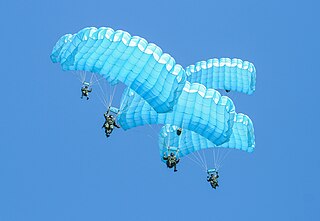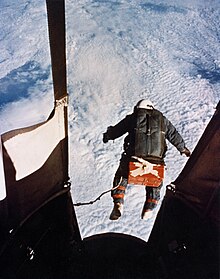
A parachute is a device used to slow the motion of an object through an atmosphere by creating drag or, in a ram-air parachute, aerodynamic lift. A major application is to support people, for recreation or as a safety device for aviators, who can exit from an aircraft at height and descend safely to earth.

Joseph William Kittinger II was an officer in the United States Air Force (USAF) who served from 1950 to 1978, and earned Command Pilot status before retiring with the rank of colonel. He held the world record for the highest skydive—102,800 feet (31.3 km)—from 1960 until 2012.

High-altitude military parachuting, or military free fall (MFF), is a method of delivering military personnel, military equipment, and other military supplies from a transport aircraft at a high altitude via free-fall parachute insertion. Two techniques are used: HALO and HAHO.

A gas balloon is a balloon that rises and floats in the air because it is filled with a gas lighter than air. When not in flight, it is tethered to prevent it from flying away and is sealed at the bottom to prevent the escape of gas. A gas balloon may also be called a Charlière for its inventor, the Frenchman Jacques Charles. Today, familiar gas balloons include large blimps and small latex party balloons. For nearly 200 years, well into the 20th century, manned balloon flight utilized gas balloons before hot-air balloons became dominant. Without power, heat or fuel, untethered flights of gas balloons depended on the skill of the pilot. Gas balloons have greater lift for a given volume, so they do not need to be so large, and they can stay up for much longer than hot air balloons.

Project Manhigh was a pre-Space Age military project that took men in balloons to the middle layers of the stratosphere, funded as an aero-medical research program, though seen by its designers as a stepping stone to space. It was conducted by the United States Air Force between 1955 and 1958.

Pyotr Ivanovich Dolgov was a colonel in the Soviet Airborne forces. Dolgov died while carrying out a high-altitude parachute jump from a Volga balloon gondola.

Lieutenant Commander Victor Alonzo Prather Jr. was an American flight surgeon famous for taking part in "Project RAM", a government project to develop the space suit. On May 4, 1961, Prather drowned during the helicopter transfer after the landing of the Strato-Lab V balloon flight, which set an altitude record for manned balloon flight which stood until 2012.

Felix Baumgartner is an Austrian skydiver, daredevil and BASE jumper. He is widely known for jumping to Earth from a helium balloon from the stratosphere on 14 October 2012 and landing in New Mexico, United States, as part of the Red Bull Stratos project. Doing so, he set world records for skydiving an estimated 39 km (24 mi), reaching an estimated top speed of 1,357.64 km/h (843.6 mph), or Mach 1.25. He became the first person to break the sound barrier relative to the surface without vehicular power on his descent. He broke skydiving records for exit altitude, vertical freefall distance without a drogue parachute, and vertical speed without a drogue. Though he still holds the two latter records, the first was broken two years later, when on 24 October 2014, Alan Eustace jumped from 135,890 feet with a drogue.

Malcolm David Ross was a captain in the United States Naval Reserve (USNR), an atmospheric scientist, and a balloonist who set several records for altitude and scientific inquiry, with more than 100 hours flight time in gas balloons by 1961. Along with Lieutenant Commander Victor A. Prather (USN), he set the altitude record for a manned balloon flight.

This listing of flight altitude records are the records set for the highest aeronautical flights conducted in the atmosphere, set since the age of ballooning.

Similar to skydiving, space diving is the act of jumping from an aircraft or spacecraft in near space and falling towards Earth. The Kármán line is a common definition as to where space begins, 100 km (62 mi) above sea level. This definition is accepted by the Fédération Aéronautique Internationale (FAI), which is an international standard setting and record-keeping body for aeronautics and astronautics. The United States Air Force uses 50 mi (80 km) to award astronaut wings.
Michel Fournier is a French adventurer and retired Air Force colonel. He has been involved in planning attempts to break freefall jumping height records, but has yet to be successful in carrying out an attempt. He was born in Treban (Allier), in the Auvergne region of France.

Parachuting and skydiving is a method of transiting from a high point in an atmosphere to the ground or ocean surface with the aid of gravity, involving the control of speed during the descent using a parachute or parachutes.

Osoaviakhim-1 was a record-setting, hydrogen-filled Soviet high-altitude balloon designed to seat a crew of three and perform scientific studies of the Earth's stratosphere. On January 30, 1934, on its maiden flight, which lasted over 7 hours, the balloon reached an altitude of 22,000 metres (72,000 ft). During the descent the balloon lost its buoyancy and plunged into an uncontrolled fall, disintegrating in the lower atmosphere. The three crew members, probably incapacitated by high g-forces in a rapidly rotating gondola, failed to bail out and were killed by the high-speed ground impact.

Nicholas John Piantanida was an American amateur parachute jumper who reached 123,500 feet with his Strato Jump II balloon on February 2, 1966, flying a crewed balloon higher than anyone before, a record that stood until Felix Baumgartner's flight on October 14, 2012.
Red Bull Stratos was a high-altitude skydiving project involving Austrian skydiver Felix Baumgartner. On 14 October 2012, Baumgartner flew approximately 39 kilometres (24 mi) into the stratosphere over New Mexico, United States, in a helium balloon before free falling in a pressure suit and then parachuting to Earth. The total jump, from leaving the capsule to landing on the ground, lasted approximately ten minutes. While the free fall was initially expected to last between five and six minutes, Baumgartner deployed his parachute after 4 minutes and 19 seconds.

Yevgeny Nikolayevich Andreyev was a colonel in the Soviet Air Force. He set an official record for the longest-distance free-fall parachute jump on 1 November 1962, which the Guinness Book of Records put at 24,500 metres (80,400 ft). The previous record holder for highest free-fall jump was Joseph Kittinger. However, Andreyev did not break the record for highest parachute jump, also held by Kittinger, but that jump was stabilized by a drogue parachute and therefore not free-fall. Andreyev was awarded the Hero of the Soviet Union for his feat.

Robert Alan Eustace is an American computer scientist who served as Senior Vice President of Engineering at Google until retiring in 2015. On October 24, 2014, he made a free-fall jump from the stratosphere, breaking Felix Baumgartner's world record. The jump was from 135,890 feet (41.42 km) and lasted 15 minutes, an altitude record that stands as of 2023.

On October 24, 2014, Alan Eustace broke the record for the highest stratosphere jump, releasing himself from a balloon at 135,908 feet.





















